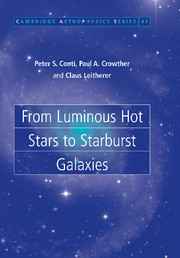Book contents
- Frontmatter
- Contents
- Preface
- Acknowledgements
- 1 Introduction
- 2 Observed properties
- 3 Stellar atmospheres
- 4 Stellar winds
- 5 Evolution of single stars
- 6 Binaries
- 7 Birth of massive stars and star clusters
- 8 The interstellar environment
- 9 From giant HII regions to HII galaxies
- 10 Starburst phenomena
- 11 Cosmological implications
- References
- Acronyms
- Symbols
- Object index
- Subject index
11 - Cosmological implications
Published online by Cambridge University Press: 28 October 2009
- Frontmatter
- Contents
- Preface
- Acknowledgements
- 1 Introduction
- 2 Observed properties
- 3 Stellar atmospheres
- 4 Stellar winds
- 5 Evolution of single stars
- 6 Binaries
- 7 Birth of massive stars and star clusters
- 8 The interstellar environment
- 9 From giant HII regions to HII galaxies
- 10 Starburst phenomena
- 11 Cosmological implications
- References
- Acronyms
- Symbols
- Object index
- Subject index
Summary
Less than a few hundred thousand years after the Big Bang, the temperature was high enough that cosmic gas consisted of protons, free electrons and light nuclei. Once the Universe cooled to about 3000 K, the electrons and protons were moving sufficiently slowly that they combined to form hydrogen atoms. With scattering of photons much reduced, they were able to move in straight lines indefinitely, and may be seen redshifted into the microwave part of the spectrum as the 2.7K CMB. So began the era of recombination, or so-called “dark ages” when the IGM became mostly neutral. Within the current cold Dark Matter model for the hierarchical formation of structure, mini-halos of mass ∼106M⊙ (Couchman & Rees 1986) provided the gravitational seeds for the first stars at z ≈ 20–30, ending the “dark ages” through re-ionization of the IGM. A comprehensive review of the astrophysical role of dark matter is provided by Jungman, Kamionkowski, & Griest (1996).
Galaxies formed as baryonic gas cooled in the centers of dark matter structures, from which galaxy mass built up via mergers of halos and proto-galaxies (White & Rees 1978; Davis et al. 1985). Since most present-day galaxies are relatively old, it follows that they formed at z ≥2. The timescale over which galaxies assembled remains unclear, particularly the bulges and disks which are the main components of present-day galaxies.
- Type
- Chapter
- Information
- From Luminous Hot Stars to Starburst Galaxies , pp. 266 - 293Publisher: Cambridge University PressPrint publication year: 2008

